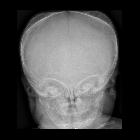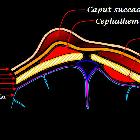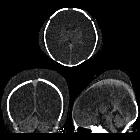Cephalohematoma


Cephalohematomas are traumatic subperiosteal hematomas of the skull that are usually caused by birth injury. They are bound between the periosteum and cranium, and therefore cannot cross sutures. Being bound by a suture line distinguishes them from subgaleal hematoma, which can cross sutures.
Epidemiology
Cephalohematomas occur in 1-2% of live births. The incidence increases with ventouse and forceps extraction and thus more common in primiparous mothers. There may be a greater male predilection .
Radiographic features
Cephalohematomas are clinically diagnosed and infrequently imaged. They can be unilateral or bilateral, and appear as subgaleal fluid collections bounded by suture lines. In the setting of craniosynostosis, the blood products are able to traverse the affected suture . By 2-3 weeks, they may become peripherally calcified . The hematoma usually resolves in 2-3 months.
Ultrasound
- separation of the scalp by subperiosteal hemorrhage of moderate echogenicity
- underlying brain is usually normal
Complications
Treatment and prognosis
Most resolve spontaneously.
Related articles
- scalp hematoma
- caput succedaneum
- subgaleal hematoma
- cephalohematoma
See also
Siehe auch:
und weiter:

 Assoziationen und Differentialdiagnosen zu Cephalohematoma:
Assoziationen und Differentialdiagnosen zu Cephalohematoma:



